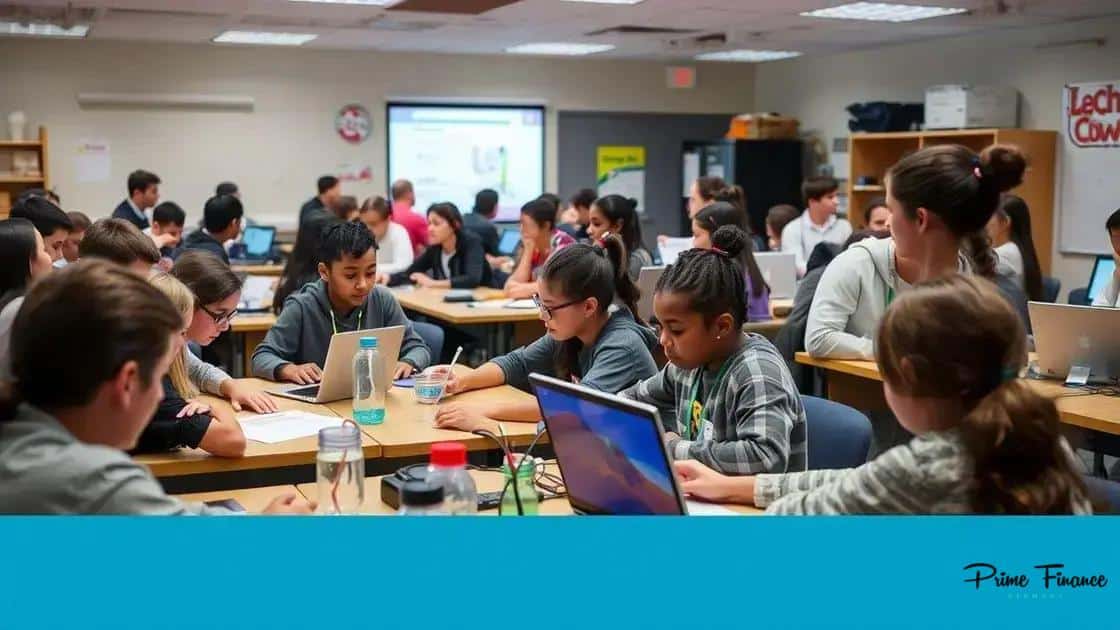Public-private partnerships in funding educational initiatives

Public-private partnerships in funding educational initiatives enhance learning opportunities by combining resources from both sectors, leading to improved educational outcomes and innovative programs for students.
Public-private partnerships in funding educational initiatives are reshaping how schools operate, creating new opportunities for innovation and growth. Have you ever wondered how these collaborations impact local education? Let’s dive in.
Understanding public-private partnerships
Understanding public-private partnerships (PPPs) is essential for grasping how educational initiatives can be effectively funded. These partnerships create a synergy between the public sector, which often provides the regulatory framework and public funding, and the private sector, which brings in resources, expertise, and innovation.
PPPs can take various forms, each contributing uniquely to educational environments. For instance, they might involve direct financial investments from private companies in public schools or collaborations aimed at enriching educational programs with business insights.
Types of public-private partnerships
There are several types of PPPs, each serving different purposes within the educational landscape:
- Funding Initiatives: Financial backing from private entities to support school projects.
- Resource Development: Providing educational materials or infrastructure through partnerships.
- Program Development: Collaborating on curricula or training programs tailored to industry needs.
Such collaborations not only enhance educational quality but also help prepare students for real-world challenges. Each partnership can be tailored to meet specific community needs, ensuring that both students and educators benefit from the initiative.
Moreover, the engagement of private companies often leads to innovative teaching methods and access to modern technology that might not be available in traditional public funding models. This integration fosters a more engaging learning environment.
Challenges of public-private partnerships
Of course, navigating PPPs is not without challenges. Governance and accountability are critical aspects that need careful consideration. Ensuring that these partnerships serve the public interest while meeting the expectations of private investors is vital.
- Transparency: Maintaining open channels of communication among all stakeholders.
- Equity: Ensuring that all students benefit equally from the partnership.
- Long-term Commitment: Fostering relationships that last beyond short-term projects.
Ultimately, understanding public-private partnerships helps stakeholders appreciate the potential for these initiatives to revolutionize funding in education. By aligning the goals of both sectors, we can enhance learning opportunities and ensure that all students are equipped with the skills they need for future success.
Benefits for educational institutions

The benefits for educational institutions that engage in public-private partnerships are significant and far-reaching. These collaborations allow schools to access resources that may otherwise be unavailable, giving students opportunities for growth and enrichment.
One major advantage is the infusion of financial resources. When private entities invest in public education, it often leads to new educational programs, updated technology, and improved facilities. This funding can transform the learning environment, enabling teachers to deliver better education.
Enhanced Learning Opportunities
Through these partnerships, educational institutions can develop unique programs tailored to the needs of students. Businesses can offer insights into current job markets, ensuring that curricula align with real-world demands.
- Real-life Experience: Students can benefit from internships and mentorship programs provided by private companies.
- Workshops and Seminars: Industry professionals can conduct workshops that enhance skill sets.
- Scholarship Opportunities: Private funding can create scholarships for deserving students.
Additionally, when schools partner with businesses, they often gain access to advanced technology and resources that enhance teaching and learning. This can include everything from classroom software to state-of-the-art laboratory equipment, which can vastly improve student engagement.
Strengthened Community Connections
Public-private partnerships also foster stronger connections within the community. By collaborating with local businesses, schools can involve parents and community members in the educational process. This collaboration helps build trust and ensures that efforts meet the needs of local families.
Such partnerships can also bring community resources directly into the classroom. When local businesses participate in educational initiatives, they invest in the community’s future, demonstrating a commitment to local success.
Moreover, partnerships can generate positive publicity for both schools and businesses. When successful initiatives are launched, they highlight the benefits of collaboration, encouraging others to engage in similar ventures. By showcasing success stories, educational institutions can inspire further partnerships and innovations.
Key challenges to consider
Understanding the key challenges to consider in public-private partnerships is crucial for any educational institution looking to engage in such initiatives. While these partnerships carry many benefits, they also come with potential pitfalls that must be addressed to ensure success.
One challenge is balancing the interests of both sectors. The public sector’s goal is to provide quality education, while the private sector seeks to generate returns on investment. Aligning these objectives requires careful planning and communication to foster mutual understanding.
Governance and Accountability
Governance structures need to be established to ensure that all parties are held accountable. Clear roles and responsibilities must be defined to prevent misunderstandings. Having a framework for oversight can help maintain trust among stakeholders.
- Transparency: Open communication fosters trust and prevents conflicts.
- Performance Metrics: Establishing indicators to measure success helps track progress.
- Regular Reviews: Routine evaluations keep the partnership aligned with its goals.
Another significant challenge is managing community expectations. When entering into partnerships, schools must communicate what they hope to achieve and how they plan to honor their commitments. Failure to do so can lead to skepticism and resistance from parents and community members.
Equity and Access
Equity is also a critical concern when implementing public-private partnerships. It’s essential to ensure that all students benefit from these initiatives, especially in underserved areas. When designing programs, schools must be mindful not to deepen existing inequalities.
Additionally, while private investments can enhance educational offerings, they might also introduce disparities in access to resources. Schools need to devise strategies that ensure equitable distribution of benefits to all students, regardless of background or location.
Lastly, the long-term sustainability of these partnerships can be uncertain. Relying heavily on private funding may create vulnerabilities if the business’s priorities change. Educational institutions should develop contingency plans and diversify funding sources to mitigate these risks.
Successful case studies

Exploring successful case studies of public-private partnerships in education reveals how effective collaboration can lead to transformative outcomes. These examples highlight the potential for innovation, enhanced learning experiences, and positive community impact.
One notable case is the partnership between a local school district and a technology company. The tech firm provided resources to create a digital learning environment that benefitted both students and teachers. With the company’s support, the school implemented adaptive learning software, allowing personalized instruction tailored to each student’s needs.
Case Study: Boosting STEM Education
In another example, a public school collaborated with a private aerospace company to enhance its STEM education programs. The partnership involved hands-on workshops where students learned about engineering principles while working on real-world projects.
- Workshops: Students engaged in design challenges, promoting critical thinking.
- Mentorship: Company engineers mentored students, offering guidance and insights.
- Field Trips: Students toured the company’s facilities to see their learning in action.
This partnership not only increased student interest in STEM fields but also resulted in improved test scores, illustrating the benefits of active engagement with industry professionals. Students gained practical skills and knowledge that directly aligned with job market needs.
Case Study: Community Health Initiative
Another inspiring partnership involved a local university and a healthcare provider to promote health education in schools. Together, they developed a program that addressed health literacy and wellness principles, providing students with essential knowledge about nutrition and physical fitness.
The collaboration produced materials for classrooms and organized health fairs where students could interact with professionals. This hands-on approach helped students understand the importance of healthy living while fostering community ties.
These successful case studies show that public-private partnerships can create innovative solutions to educational challenges. By combining resources and expertise, schools can enrich the learning experience and prepare students for future success in their communities.
Strategies for implementation
Implementing public-private partnerships in education requires careful planning and execution. Effective strategies for implementation can foster collaboration and ensure the benefits of these partnerships reach all students.
The first step is to involve stakeholders early in the process. Building a coalition that includes educators, business leaders, and community members can help align objectives and resources. When everyone is on board, the partnership is more likely to succeed.
Defining Clear Goals
Establishing specific and measurable goals is critical for any partnership. These goals should reflect the needs of the students and the community. For instance, if a school aims to improve STEM learning, the partnership might focus on providing resources for science labs and training teachers in new technologies.
- Identify Resources: Assess what each partner can contribute, such as funding, expertise, or facilities.
- Develop Action Plans: Create a detailed roadmap with timelines and responsibilities clearly outlined.
- Monitor Progress: Regular check-ins can help identify challenges and adjust goals as needed.
Another effective strategy is to leverage existing programs and resources. Many communities already have frameworks for educational improvement. By partnering with these established programs, schools can enhance their initiatives without starting from scratch.
Building Trust and Communication
Building trust among partners is essential. Open communication fosters a collaborative environment where ideas can be shared freely. Regular meetings and updates help maintain transparency and keep everyone informed.
Furthermore, educating all parties about each other’s missions and objectives can create a shared purpose. When educators understand business objectives and vice versa, they can work together more effectively to achieve the partnership’s goals.
Lastly, ensure that the partnership remains flexible and adaptable. The educational landscape is always changing, and partnerships should be willing to evolve. Regular feedback from teachers, students, and partners can provide valuable insights to improve the collaboration.
FAQ – Frequently Asked Questions about Public-Private Partnerships in Education
What are public-private partnerships?
Public-private partnerships are collaborations between public educational institutions and private entities, aimed at enhancing educational resources and opportunities.
What benefits do these partnerships offer?
These partnerships can provide additional funding, resources, and expertise, helping to create better learning environments for students.
How can schools ensure successful partnerships?
Successful partnerships require clear communication, defined goals, and active engagement of all stakeholders involved.
What challenges might schools face?
Challenges include aligning the interests of both sectors, maintaining transparency, and ensuring equitable access to resources for all students.





